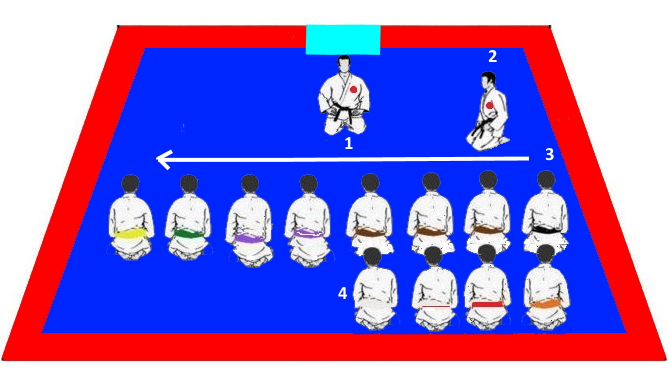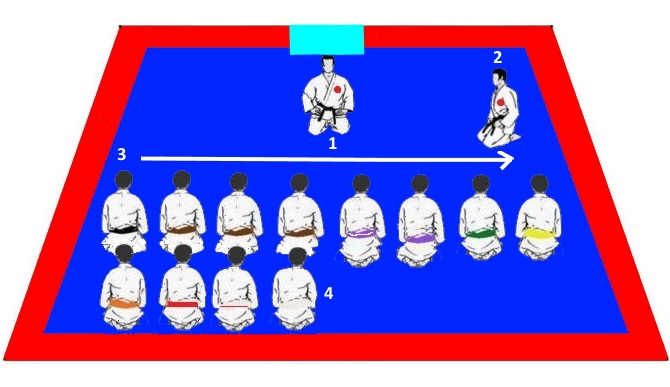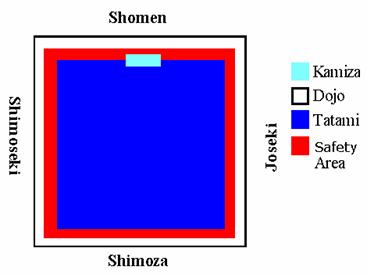"Coaching The SKU Way!" Official SKU Coaching Resource
First Published May 2016 Issue 63 SKU Quarterly Magazine
Where is the correct training position in the Dojo?
by Derick Kirkham
The following question was asked by a confused Dan grade, upon his return from an SKU sponsored training/study trip to Japan. While there he had trained at both a JKA & an SKIF dojo. His dilemma arose when he noticed that there was disagreement between the two major factions. One of the groups had the senior grades line up with highest graded Karate-ka standing on the far right of the dojo. While the other group had them line up from the left.
He asked me “Which is the correct method?”
Strictly for the purpose of illustration to answer his question fully, if we detail the methodology that is being used by the current JKA HQ regime.
Is where the Highest Ranking student will assume a front row position at the far right side of the Dojo Joseki. In other words as they look towards the Instructor they will be on the front row on the far right of the Dojo looking towards Shomen.
Therefore, as the Instructor looks towards the class, the Highest Ranking student will be on the front row on the left hand side of the dojo, the Joseki.
All other Karate-Ka will stand in line and in descending rank order. They will be to the left of their fellow senior Karate-Ka, as shown in the diagram: 1.
If there are several Karate-Ka in the class who are of the same grade status, then seniority is based upon when the student’s grade was achieved.
If there are many Karate-Ka who are of the same grade and seniority then the elder of the Karate-Ka within that graded group will be deemed to be the senior rank.
I need at this point to make the distinction between the JKA old guard and that of the new JKA HQ regime, which have made a shift from lining up from the left, towards lining up from the right as detailed above. This shift however, has not been accepted wholesale by the JKA organisation as there are still JKA affiliates around the world, who on their websites, are still stating that students should line up from the left.
To adjudicate between left or right, or even to just find a rationale, then we need to look towards what is done and why in the Traditional Japanese Dojo’s from more socially senior Martial Arts, such as Kendo & Iaido, where the spiritual & cultural influences are more openly acknowledged. All most everything in the martial arts is done for a reason, and the theory behind lining up in the dojo from the left is strongly based hundreds of years earlier in the spiritual and cultural heritage of the country. The Japanese have long held the belief that the left is a more dominant, and is a more important position, than that of the right. The significance of lining up from the left in a bushido a samurai setting was one of practicality. In modern personnel security parlance, it was the equivalent of, “keeping the principle secure.” By adopting the lining up the seniors from the front left position, the samurai was keeping their higher ranking officials, or in the dojo setting the sensei, the furthest away from the entrance of the dojo, as it was considered to be the weakest area in the dojo, if one was to be subjected to a surprise attack.
There are however, no such compelling arguments available to explain the reason for lining up from the right or for changing to it. Having coached at dojos around the world I am never thrown when presented by this discrepancy and I never insist that the dojo change what they believe to be correct. I do however, introduce the historical rationale for lining up from the left and then leave it up to the dojo instructor to make the choice, as generally speaking it does not impact up on nor does it limit the training methodology employed by the dojo. And that was exactly the explanation that I gave to my Dan Grade, “If it doesn't affect the efficiency of ones learning or our enjoyment of training; then does it really matter?”

diagram: 1 right to left
1: Sensei.
2: Dojo Captain or Visitors.
3: Highest Ranking Student.
4: Lowest Ranking Student or Ungraded Novice.

diagram: 2 left to right
The Dojo 道場 Layout Explained
This is the layout of a Traditional Japanese Dojo 道場 and they are formulated from the layout of Shinto shrines and from the Taoist cosmology philosophies. There are some minor variations from style to style and with its usage within other Martial Arts. But this layout is the most widely used layout in Japanese Shotokan Karate-do.

Shomen 正面 (true face) Shomen is the front of the Dojo. It’s the direction that students line up facing and they traditionally bow towards. Shomen is the Northern wall of the Dojo or the wall that is facing the Dojo entrance. It’s where the Shinto shrine, the Country flag and the Dojo Kun are situated. In some Martial Arts it is associated with the water element and the quality of wisdom in judgement.
Kamiza 上座 sometimes referred to as Shinza (seat of gods). Kamiza is the place of honour and is reserved for instructors, honoured guests. While referring to a sitting place, it is often confused with the word kamidana, but this is not correct. Kamiza refers to the front region of the dojo, where the pictures of respected instructors (O'Sensei) are. Kamiza is also the area where the Sensei instructs from and sits when they are grading students.
Tatami 畳 are Japanese rush mats. But in modern Dojos they are foam training mats or wooden sprung flooring. This central area of the Dojo is sometimes known as Embujo and is associated with the element of Earth and the quality of Honesty.
Safety Area 周囲 is a designated area on the parameter that one should not cross. It’s the area when sparring if crossed then the fight must be stopped for leaving the area. It is the area that any non-participant must never cross.
Joseki 上席 (upper side) this is the east side of Dojo. Joseki is where senior students Dan Grades (Sempai & Yudansha) sit in seiza. Joseki is the right side of the dojo when facing Shomen. It’s associated with the element of wood and the quality of virtue and clarity in thought.
Shimoza 下座 (lower seat) It is the back the south of the Dojo. Shimoza is opposite Kamiza and is facing Shomen. It’s where students sit in rank order awaiting instructions. It’s associated with the element fire and the quality of intelligence.
Shimoeski 下関 (lower side) it is the left side, the west side of the Dojo when facing Shomen. It’s the side of the Dojo where the junior students, Kyu Grades, (Kohai Mudansha) sit in seiza. It’s associated with the element of metal and the quality of moral righteousness.
Nafuda Kake 名札かけ Is the notice board where name plaques of the student’s rankings are placed.
Genkan 玄関 is the entrance hall where outdoor shoes are left in a Traditional Japanese Dojo.
Good Luck and Good Practice.
